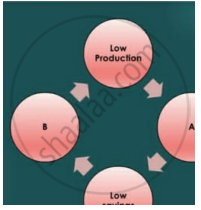Advertisements
Advertisements
प्रश्न
Underscore some of the India’s most crucial economic challenges at the time of independence.
उत्तर
The exploitative colonial rule of the British hampered almost every spheres of Indian economy badly. As an end-result, India faced acute economic challenges at the time of independence. The following are some of the economic challenges faced by the Indian economy:
1. Low Level of Agricultural Productivity: During the colonial rule Indian agricultural sector was used by the British to suit to their own interest. Consequently, Indian agricultural sector experienced stagnancy, low level of productivity, lack of investment, poor condition of landless farmers and peasants. Thus, the immediate concern for India was to develop its agricultural sector and its productivity. Some of the immediate reforms needed at the time of independence were abolition of Zamindari system, need of land reforms, reducing inequality of land ownership and upliftment of the peasants.
2. Infant Industrial Sector: India failed to develop a sound industrial base during the colonial rule. In order to develop the industrial sector, India needed huge capital, investments, infrastructure, human skills, technical knowhow and modern technology. Further, due to stiff competition from the British industries, India’s domestic industries failed to sustain. Thus, developing small scale and large scale industries simultaneously was the main concern for India to develop its industrial sector. Moreover, the need to increase the share of industrial sector to India’s GDP was one of the important economic challenges for India.
3. Lack in Infrastructure: Although there was a significant change in the infrastructural development in the country but this was not sufficient to improve the performance of agricultural and industrial sector. Also, there was a need to upgrade the existing infrastructure and to modernise the infrastructure to enhance its efficiency and effectiveness.
4. Poverty and Inequalities: India was trapped in the vicious circle of poverty and inequality. The colonial rule drained out a significant portion of India's wealth to Britain. Consequently, majority of India’s population was poverty trodden. This further exaggerated economic inequalities across the country.
APPEARS IN
संबंधित प्रश्न
What was the focus of the economic policies pursued by the colonial government in India? What were the impacts of these policies?
Name some notable economists who estimated India’s per capita income during the colonial period.
Critically appraise some of the shortfalls of the industrial policy pursued by the British colonial administration.
What do you understand by the drain of Indian wealth during the colonial period?
Were there any positive contributions made by the British in India? Discuss.
During colonial period India’s demographic profile showed ______.
Who made significant estimates about calculating national income in India during the British period?
In which of the following sectors is manufacturing activity included?
Which industry suffered a major setback during the British rule?
‘Since independence, India has witnessed a considerable fall in the Infant Mortality Rate in India’ Identify which of the following may not be one of the reasons for the fall in the Infant Mortality Rate?
Choose the correct alternatives to be filled in given blanks A and B.

What were the impacts of the economic policies pursued by the colonial government in india?
Which of the following economists estimated India's per capita income during the colonial period.
Dadabhai Naroji advocated the theory of 'Drain of Wealth' in the ______ century.
